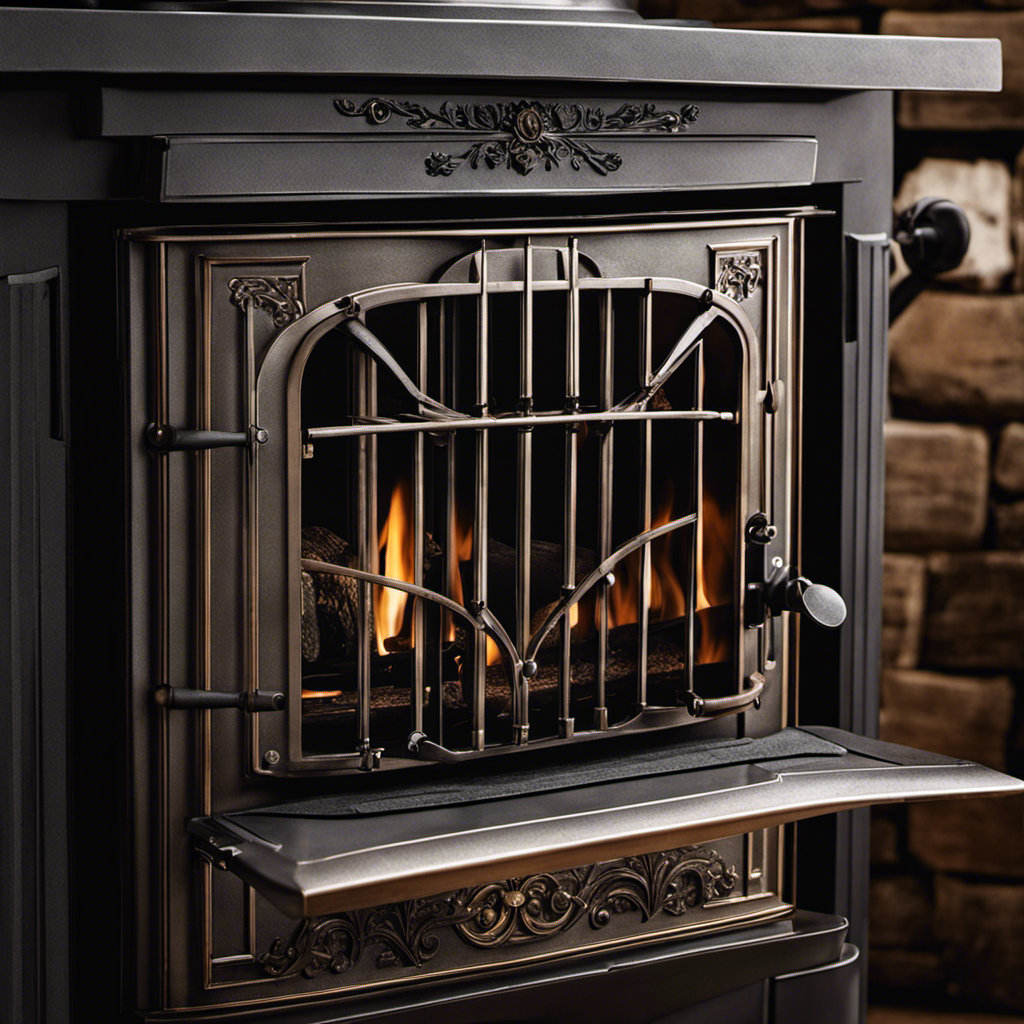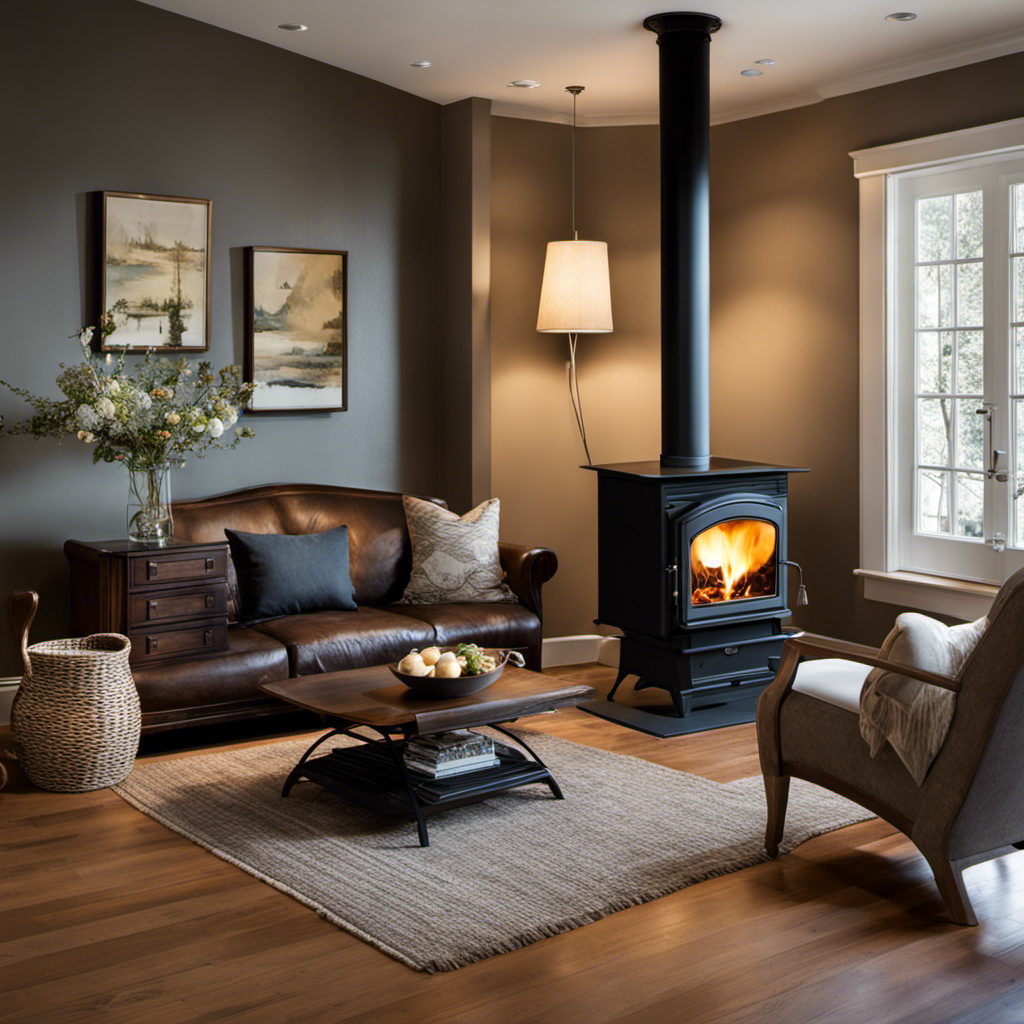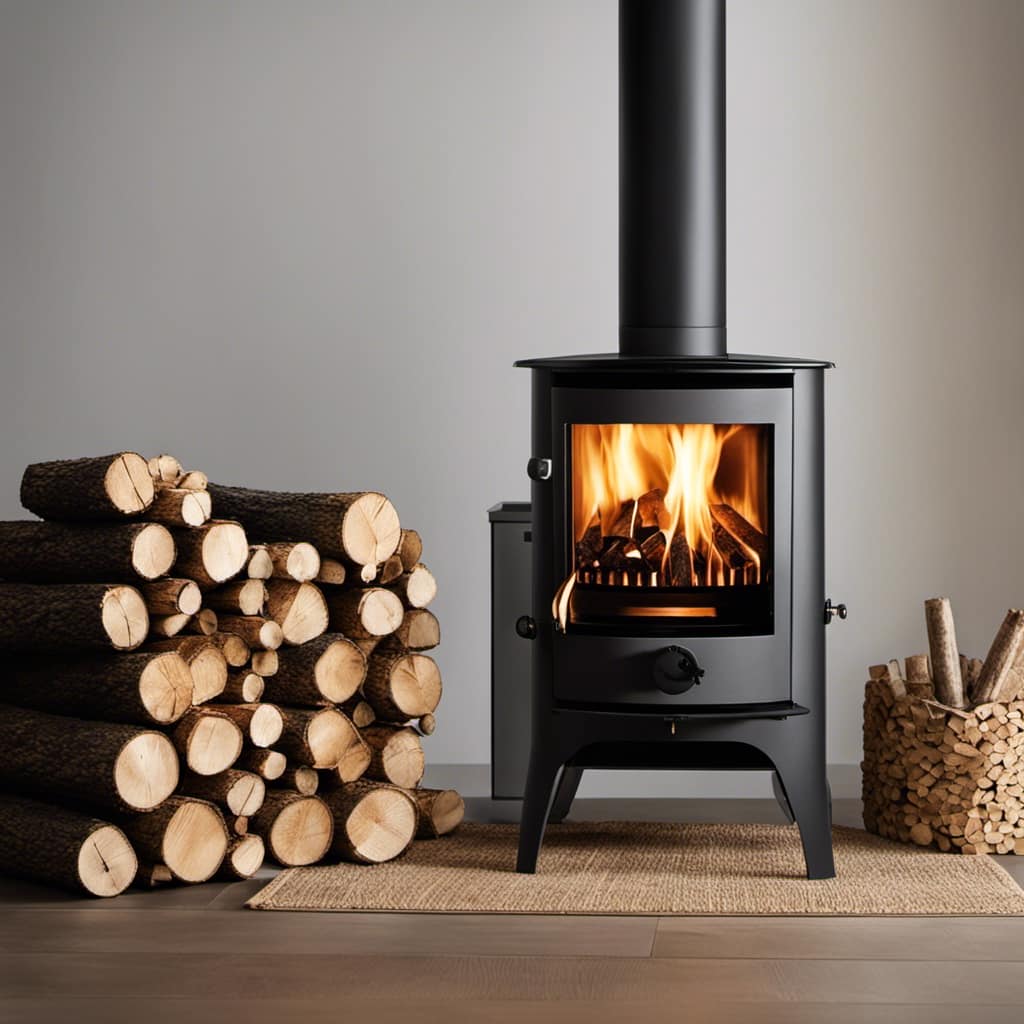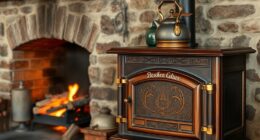As someone deeply intrigued by wood stoves, I am captivated by the workings of these classic devices. The damper plays a critical role in controlling the fire’s strength. It acts as a regulator of air circulation, guaranteeing that the burning process is efficient and the heat spreads uniformly.
In this article, we’ll delve into the mechanics of dampers, explore their impact on efficiency, and offer some handy tips for operating them effectively.
So, let’s stoke the fire of knowledge and unravel the mysteries of the wood stove damper!
Key Takeaways
- The damper controls the airflow in a wood stove.
- Regular maintenance is important to prevent airflow blockage.
- Different types of dampers work together for better heat distribution and combustion.
- Proper operation of the damper maximizes wood stove efficiency and heat distribution.
The Role of the Damper in Controlling Airflow
I really appreciate the role that the damper plays in controlling the airflow of a wood stove. It’s a crucial component that ensures optimal combustion and efficient heating.
Regular maintenance of the damper is of utmost importance to keep it functioning properly. Over time, soot and creosote can build up, leading to a decrease in airflow and potential blockage. To maintain the damper, it’s recommended to inspect and clean it at least once a year, preferably before the start of the heating season.
Adjusting the damper for optimal combustion is also essential. By opening it fully, you allow more oxygen in, resulting in a hotter fire. Conversely, closing it partially restricts airflow, leading to a slower burn rate. Finding the right balance is key to achieving efficient and clean burning in your wood stove.
Understanding the Different Types of Dampers
When considering the different types of dampers, it’s essential to understand their unique functions and how they can improve the efficiency of a wood stove. Dampers play a crucial role in controlling the airflow, allowing for better heat distribution and combustion in the stove.
There are several types of dampers commonly used in wood stoves, including the primary air damper, secondary air damper, and flue damper. These dampers work together to regulate the amount of air entering and exiting the stove, ensuring optimal burning conditions.
Proper maintenance of dampers is vital to ensure their effectiveness and prevent issues such as smoke leakage and poor heat output. Understanding the different types of dampers and their importance in damper maintenance is key to maximizing the efficiency of your wood stove.
Now, let’s delve into how the damper affects the efficiency of your wood stove.
How the Damper Affects the Efficiency of Your Wood Stove
The damper plays a significant role in improving the efficiency of your wood stove by regulating airflow and allowing for better heat distribution. The position of the damper can have a direct impact on the temperature inside the stove. When the damper is fully open, more air is allowed into the stove, resulting in a higher temperature. On the other hand, closing the damper restricts airflow, reducing the temperature. To illustrate this, let’s take a look at the table below:
| Damper Position | Wood Stove Temperature |
|---|---|
| Fully Open | High |
| Partially Open | Medium |
| Fully Closed | Low |
Regular maintenance of the damper is crucial for optimal wood stove performance. Over time, soot and creosote can build up, obstructing airflow and reducing efficiency. Cleaning the damper regularly ensures proper airflow and prevents any potential fire hazards. Additionally, inspecting the damper for any signs of damage or wear is important to address any issues promptly. By maintaining the damper, you can ensure that your wood stove operates efficiently and provides consistent heat distribution.
Tips for Properly Operating the Damper
Properly operating the damper is essential for maximizing the efficiency of your wood stove and ensuring optimal heat distribution. When it comes to proper damper maintenance, there are a few key things to keep in mind:
-
Regular cleaning: A clean damper allows for smooth operation and prevents the buildup of creosote, which can be a fire hazard.
-
Positioning: The position of the damper controls the flow of air and regulates the intensity of the fire. Adjusting it correctly can help you achieve the desired temperature and prevent excessive heat loss.
-
Inspection: It’s important to regularly inspect the damper for any signs of damage or wear. Cracks or leaks can impact its effectiveness, leading to energy loss and reduced efficiency.
Common Issues and Troubleshooting With Wood Stove Dampers
I’ve encountered a few common issues with wood stove dampers, but by troubleshooting them, I’ve been able to maintain optimal heat distribution. One of the most common problems is a stuck damper, which can prevent proper airflow and cause inefficient burning. To fix this, I use a lubricant to loosen the mechanism and ensure smooth operation. Another issue is a damaged or warped damper, which can lead to heat loss and poor combustion. In such cases, I replace the damper to restore its functionality. Regular maintenance and cleaning are also crucial to prevent buildup of creosote, which can obstruct the damper’s movement. By following these troubleshooting techniques and practicing proper maintenance and cleaning, I’ve been able to keep my wood stove damper in excellent working condition.
| Common Issues | Troubleshooting Techniques |
|---|---|
| Stuck Damper | Use lubricant to loosen mechanism |
| Damaged/Warped Damper | Replace damper for optimal heat distribution |
| Creosote buildup | Regular maintenance and cleaning to prevent obstruction |
Frequently Asked Questions
Can a Wood Stove Be Operated Without a Damper?
Yes, a wood stove can be operated without a damper, but it is not recommended for wood stove safety reasons. The damper helps control the airflow, allowing for more efficient burning and reducing the risk of smoke or gas buildup.
How Often Should the Damper Be Cleaned or Maintained?
Proper maintenance of a wood stove damper is of utmost importance. Regular cleaning is crucial to ensure its optimal functionality. Let me share some techniques for cleaning and maintaining the damper effectively.
Can a Damper Be Installed on an Existing Wood Stove?
Installing a damper on an existing wood stove has both pros and cons. The process involves a few steps, including measuring the flue, selecting the right damper, and securing it in place.
What Are the Signs of a Malfunctioning Damper?
When troubleshooting damper issues, signs of a malfunctioning damper can include difficulty controlling the airflow, excessive smoke, or a lack of heat. It’s important to address these issues promptly to maintain optimal performance.
Can a Damper Be Used to Control the Intensity of the Fire in a Wood Stove?
Yes, a damper can be used to control the intensity of the fire in a wood stove. By adjusting the damper, you can regulate the amount of air entering the stove, thereby controlling the burn rate and heat output. This can be beneficial for maintaining a comfortable temperature and conserving fuel. As for damper maintenance tips, it is important to regularly clean and inspect the damper to ensure it is functioning properly. This includes removing any debris or creosote buildup and ensuring that the damper opens and closes smoothly. Regular maintenance will help ensure optimal performance and efficiency of your wood stove.
Conclusion
In conclusion, the damper on a wood stove acts as a crucial control mechanism for regulating airflow and maximizing the efficiency of the stove.
Like a conductor guiding the flow of air, the damper ensures that the fire receives the right amount of oxygen for optimal burning.
It symbolizes the balance between heat and ventilation, highlighting the importance of careful operation and maintenance to enjoy a warm and comfortable fire.
By understanding how the damper works, you can enhance your wood stove experience and make the most of your heating appliance.
Logan’s affair with adventure began in childhood. He hailed from a small town where vast forests bordered one side and endless shores stretched on the other. His days were spent exploring uncharted woods, climbing tall trees, or listening to the tales of old sailors. This early immersion in a world brimming with stories and mysteries became the foundation of his passion for writing.











